A History of the County of Hertford: Volume 3. Originally published by Victoria County History, London, 1912.
This free content was digitised by double rekeying. All rights reserved.
'Parishes: Little Wymondley', in A History of the County of Hertford: Volume 3, ed. William Page( London, 1912), British History Online https://prod.british-history.ac.uk/vch/herts/vol3/pp185-191 [accessed 26 November 2024].
'Parishes: Little Wymondley', in A History of the County of Hertford: Volume 3. Edited by William Page( London, 1912), British History Online, accessed November 26, 2024, https://prod.british-history.ac.uk/vch/herts/vol3/pp185-191.
"Parishes: Little Wymondley". A History of the County of Hertford: Volume 3. Ed. William Page(London, 1912), , British History Online. Web. 26 November 2024. https://prod.british-history.ac.uk/vch/herts/vol3/pp185-191.
In this section
LITTLE WYMONDLEY
This parish has an area of 1,006 acres, of which 599 acres are arable land, 226½ acres permanent grass and 6½ acres wood. (fn. 1) Two portions of the parish are detached. One of very small area lies west of Redcoats Green and the other is situated south of Titmore Green and contains a few cottages which are called Lower Titmore Green. The parish slopes downward in a south-westerly direction from an elevation of nearly 400 ft. The Great Northern railway passes through the village, but the nearest stations are Stevenage, 2 miles south-east, and Hitchin, 2½ miles north-west. The village lies on the road from Hitchin to Stevenage. Near its centre a road branches off northwards to Great Wymondley, passing the site of the former priory. The Great North Road runs along the north-east boundary of the parish. The subsoil is chalk with a layer of boulder clay; the surface soil is clay and gravel with occasional chalk. There is a chalk-pit south of the village and a gravel-pit in a field east of the vicarage. The village has many old and picturesque cottages. The Buck's Head Inn is an early 17th-century timber and plaster house, with an overhanging gable at each end, and the 'Plume of Feathers' is an old red brick house on the opposite side of the road.
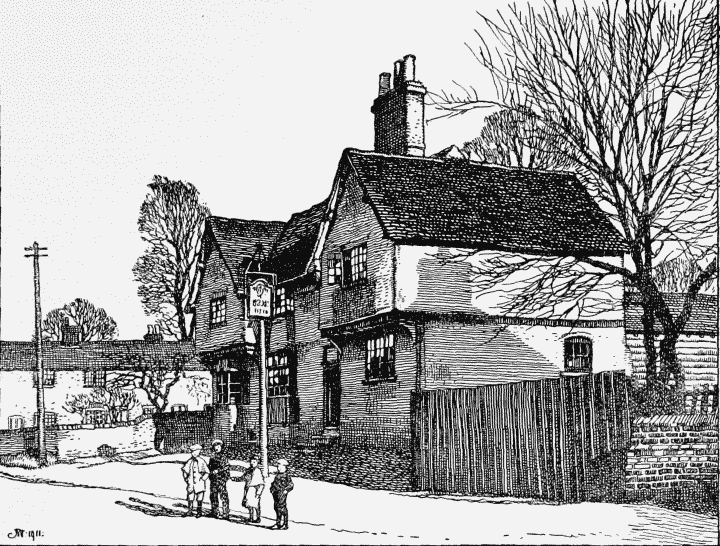
Buck's Head Inn, Little Wymondley
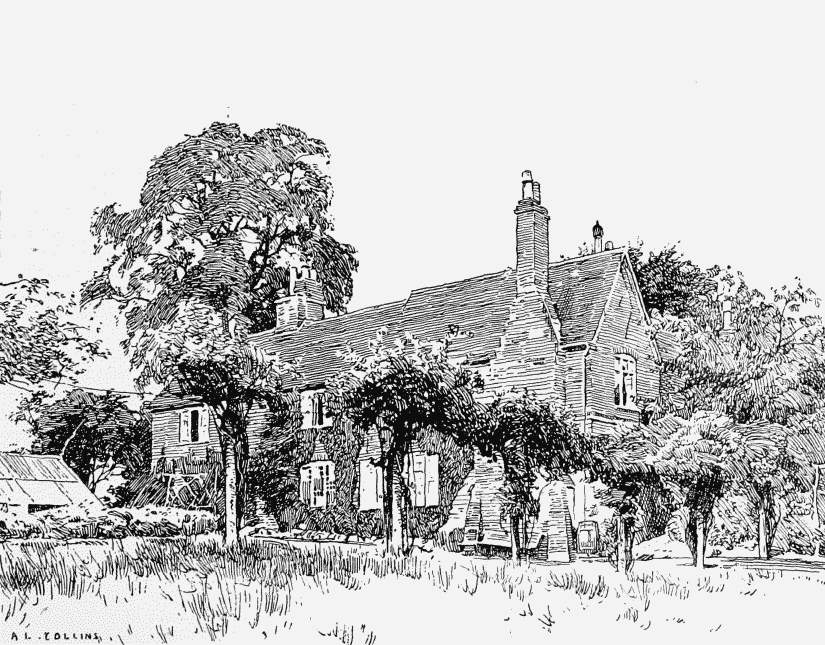
Little Wymondley Bury from the East
Wymondley Hall, now a farm-house, the residence of Mr. M. H. Foster, is a picturesque many-gabled building, standing close to the railway where it crosses the main road to Hitchin. There is nothing of architectural interest inside the building, and modern subdivisions of the rooms have destroyed all traces of the original plan. The house appears to have been erected during the early part of the 17th century, and is built of thin 2-in. bricks, with a good deal of timber-framed work covered with plaster on the upper story. The principal front, which faces west, has six gables, the two northernmost, however, being modern additions. Of the two middle gables, one has a bay window its whole height, the other having merely a slightly projecting oriel on the upper story with an entrance porch under. The south gable has a projecting upper story, timber framed and plastered, below which is a bay window, and up in the gable is an oriel window finished with a small gable under the main gable. The corresponding large gable at the north end has a projecting bay continued up the two stories and finished with a similar small gable. All the roofs are tiled. The entrance door and frame are original. The frame is moulded and square-headed, the mouldings having ornamental stops outside. Many of the features of this front, such as the moulded door frame and the subsidiary gables over the oriels and bays immediately underneath the main gables, bear a close resemblance to those on the front of Egerton House, Berkhampstead. The back of the house is chiefly remarkable for the picturesque disposition of the chimneys. There are two stacks of chimneys separated by a small projecting gable.
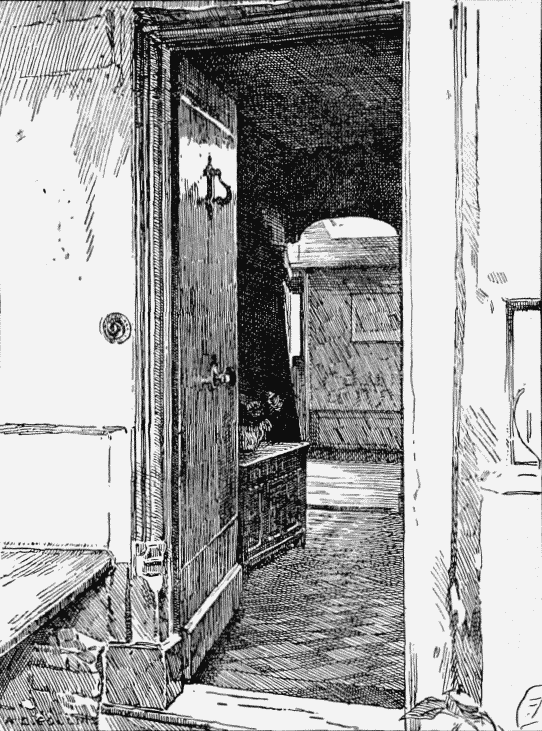
Little Wymondely Hall: Entrance Doorway
The Priory farm-house, the property of Col. Heathcote of Shephallbury and residence of Mrs. Charles Sworder, stands about half a mile north of the church on the site of part of the old Priory buildings, some parts of which are incorporated in the present house. Chauncy, writing about the year 1700, mentions the cloisters and chapel which existed in his time, but these have now almost disappeared. The plan of the house is not on the usual lines, due to the positions of the old walls; indeed, it seems that the builder of the dwelling-house merely surrounded a part of the aisleless nave of the priory church with an external wall. The old thick 13th-century walling has been a good deal cut about in order to afford passages to the different apartments, and some arches which are said to exist in the wall next the drawing room and pantry, probably part of the arcade of the north wall of the cloister, have been built up. The only arch now remaining is a portion of one of the south windows of the church over a doorway to the bedroom above the drawing room, and it appears to be in its original position. The opening is 4 ft. 8 in. wide, and has a pointed arch of 13th-century date, with arch mould consisting of two rolls with a deep hollow between, resting on a detached shaft with moulded capital. It is of soft limestone or clunch, and a portion of one side is hidden by a later wall. The oldest portion of the external wall is at the back or east side of the house. It is built mainly of clunch, and in the wall is a doorway, now built up, with splayed four-centred arch. This wall may belong to the latter part of the 16th century. All the rest of the external walling is of brick, a good deal of it refaced in modern times, but the older parts, chiefly on the north side, are faced with the original thin bricks rising about 9½ in. to four courses. On the north side are three equal gables, the windows still retaining their old oak mullions and transoms. Elsewhere the windows have been modernized. The old chimneys consist of square shafts of brick set diagonally, and probably belong to the early part of the 17th century. The west front has been much modernized. Internally many of the rooms are lined with oak moulded panelling of early 17th-century date, and there is a small plain old stair in the north-east corner of the building. The old front entrance door is now used in the doorway to the store adjoining the pantry. To the east of the house is the old garden, which still retains part of the old brick inclosure wall, at one point in which is a small niche with circular arched head of stone. There are traces of coloured ornament in the niche. South of the house is a large tithe barn of nine bays, with weather-boarded sides and tiled roof. It measures externally about 102 ft. by 39 ft. The remains of a moat are still visible, partly surrounding the house, garden and barn. Beyond the moat, to the south-east of the house, is the old orchard completely encircled by a grove of very old box trees, about 20 ft. in height. To the north-west of the house is the old dove-house, now converted into a cottage. In a field some few hundred yards north-east of the house are the remains of the old conduit head, from which water was brought to turn the spit in the kitchen, being used for that purpose until the middle of the 19th century. The conduit head is a small shallow basin sunk below the floor of a small building, some of the old floor tiles being still in their places. The walls of the building have lately been partly rebuilt, but, as no record of the old building could be found, the new work was copied from another old building elsewhere. The old stone doorway with its four-centred arch still remains.
Wymondley Bury, the residence of Mr. Henry Parkes, stands in a moated inclosure adjoining the south side of the church, a little to the south-east of the village. The moat contains water on the north-west and north-east sides of the house, but has been filled up on the other sides. The principal, or north-east, front of the house is approached by a modern bridge over the moat. The present house, which is probably only a portion of the late 16th-century house, is L-shaped, and has been much added to in the 17th century and modernized both outside and inside. All the brick facing, except to the chimneys, and all the windows have been renewed. The principal entrance still retains the old door of two thicknesses of oak planks fastened with iron studs. The dining room, to the right of the entrance, has a very interesting fireplace. The old moulded oak beam over the ingle-nook is 13 ft. 4 in. in length, and the depth of the opening is 5 ft., but its width has now been much reduced by inserting new oak jambs moulded to match the lintel. This room was probably the hall of the old manor-house. Beside the dining room is a small room used as a study, below which is an old cellar, in the walls of which are eight or nine small niches with arched heads formed in brickwork. They are placed from 3 ft. 6 in. to 4 ft. above the floor, and are from 9 in. to 11 in. wide and 9 in. in depth. Their average height is about 12 in. They were probably used to hold wine flasks. None of them appear to have had a door. There is a very similar series of niches in the cellar at Watton Place. Close to the house on the north is the old brick dovehouse which still contains some 300 nests. A little to the south-east of the house stands a fine Spanish chestnut evidently of great age but still flourishing. Gilpin refers to it in his 'Forest Scenery' about the year 1789. The main trunk is badly split, rendering any measurements misleading.
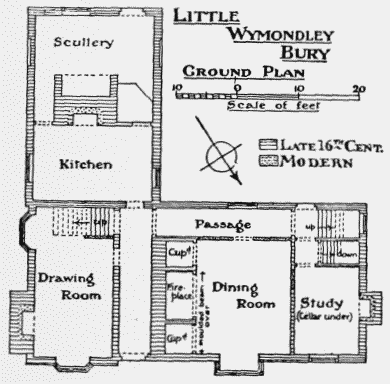
Little Wymondley Bury: Ground plan
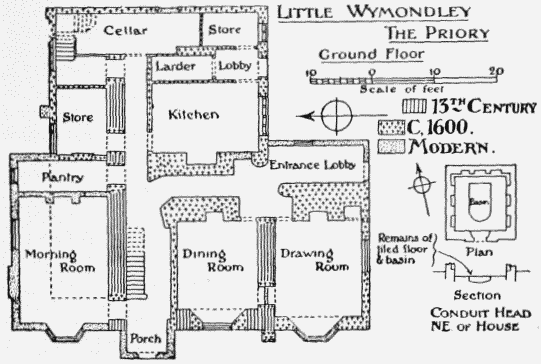
Little Wymondley: The priory, ground plan
The old manor-house of Great and Little Wymondley was probably on the same site, (fn. 2) but no trace of it now remains. It is described as 'a hall with chambers, chapels and rooms annexed,' and was called 'Somerhalle.' (fn. 3)
Wymondley House, a square modern residence, is now the residence of Mr. James W. Courtenay. From 1799 to 1832 it was used as an academy for training young men for the Nonconformist ministry. This had been founded by Dr. Doddridge at Northampton about 1738. and in 1832 was removed to London.
The inclosure award is included in that of Great Wymondley.
MANORS
Little Wymondley
Before the Norman Conquest LITTLE WYMONDLEY (Wymundeslai) was held by one Alflet of Robert Fitz Wimarc. (fn. 4) After the Conquest it was divided between two owners, 1 hide being held in 1086 by William of Robert Gernon, (fn. 5) and a hide and a quarter by Adam Fitz Hubert of the Bishop of Bayeux. (fn. 6) The lands of Adam Fitz Hubert, brother of Eudo Dapifer, went in other Hertfordshire cases to the Valognes family, but there is nothing to show what happened to them here. The Gernon lands forming the manor of Little Wymondley came to the Montfitchet family (see Letch-worth), and were divided about 1258 between the three sisters and heirs of Richard de Montfitchet, to the second of whom, Aveline, Little Wymondley was apportioned. This Aveline married William de Fortibus Earl of Albemarle, (fn. 7) who was starved to death in the Levant in 1241, and who was succeeded by his son William. The latter died in 1256 and his two children died during the lifetime of their mother. (fn. 8) The earldom of Albemarle being thus extinct, Little Wymondley was thenceforward held of the king in chief of the honour of Albemarle for 20s. rent yearly to be rendered at the ward of Craven Castle. (fn. 9) By 1419 the service was reduced to 6s. 8d. (fn. 10)
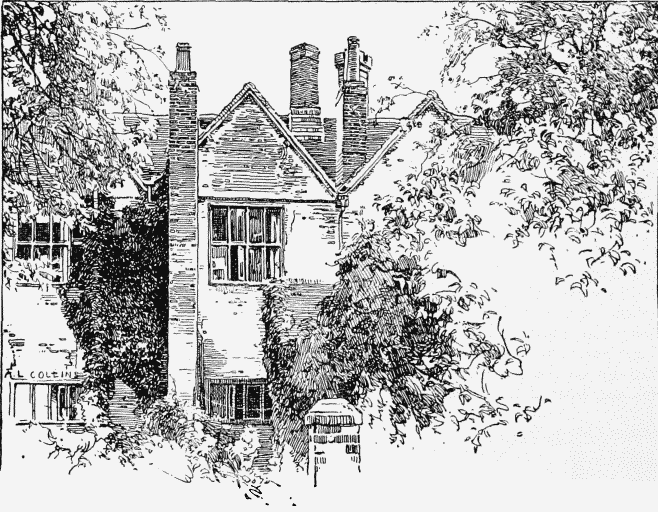
Little Wymondley Priory: North Front
Before the end of the 13th century the manor of Little Wymondley was held in sub-tenancy by the Argentein family; it is first mentioned in the possession of that family upon the delivery of the lands of Giles to his son and heir Reginald in 1282–3. (fn. 11) From that date it has followed the same descent as the manor of Great Wymondley (q.v.).
Wymondley Priory
WYMONDLEY PRIORY was founded during the reign of Henry III by Richard de Argentein, lord of the manor of Great Wymondley, some time previous to 1218. (fn. 12) It was suppressed in 1537 and the site, with the reversion of all the lands belonging to the priory, was granted to James Needham, 'accountant, surveyor-general and clerk of the king's works,' (fn. 13) to be held of the king in chief by the service of a tenth part of a knight's fee. (fn. 14) James obtained a licence to entail the manor on his son John, (fn. 15) who succeeded his father in 1545. (fn. 16) George Needham, son of John, settled the manor on his son Eustace on his marriage in 1615, and in 1623 it was settled on George the son of Eustace.

Needham. Argent a bend engrailed azure between two harts' heads caboshed sable.
George Needham the first died in 1626. (fn. 17) George the younger died in 1669 and was succeeded by another George, (fn. 18) his son, who died without male issue in 1725. (fn. 19) His heirs were his daughters, Barbara, who married John Sherwin, and Martha the wife of Thomas Browne, (fn. 20) the eminent land surveyor, who for a while resided at his wife's manor in Little Wymondley. In 1733 the manor was sold to Samuel Vanderplank, (fn. 21) from whom it is said to have descended, (fn. 22) through his daughter Anna, who married Gilbert Joddrell, to Anna Joddrell, (fn. 23) the wife of Christopher Clitherow of Essendon, who sold it in 1806 to Samuel Heathcote. In 1812 it came by the will of the latter to his grandson Samuel Heathcote Unwin, who took the additional surname of Heathcote, (fn. 24) and died in 1862. The manor descended to his son Col. Unwin UnwinHeathcote, (fn. 25) who is the present holder.
Wymondley Bury
The capital messuage called WYMONDLEY BURY, which belonged in the 16th century to Wymondley Priory (q.v.), was sold after the dissolution of that house by an indenture of 1544 to John Pigott and Margaret Grainger, whom he was about to marry. (fn. 26) John Pigott died in 1558, but the messuage remained in the possession of his widow, who married John Palmer. Upon her death in 1581 it passed to her son Maurice Pigott. (fn. 27) The latter was succeeded by Thomas Pigott, who in 1609 settled the estate upon himself and Elizabeth his wife for their lives, with remainder to his daughter Elizabeth and her husband. Thomas died in 1611, his heirs being his daughters, Rebecca wife of Henry Bull of Hertford and Elizabeth wife of Beckingham Butler, upon whom it was settled. (fn. 28) Beckingham Butler became lord of the manor of Tewin (q.v.) in 1620, and Wymondley Bury descended with that manor until at least 1746, (fn. 29) when it was held by Edmund Bull.
CHURCH
The parish church of ST. MARY stands by itself on rising ground about a quarter of a mile from the village, and is built of flint rubble cemented over, with stone dressings and a tiled roof. It consists of a chancel, nave, north aisle, north vestry, south porch and west tower. (fn. 30)
The chancel, nave and tower are of the 15th century, probably late, but the restoration in the 19th century, when the chancel was lengthened and the aisle, vestry and porch were added, has obscured the history of the building.
The east and north windows of the chancel and the chancel arch are modern. In the south wall are two single lights, probably of the 15th century, but greatly repaired with cement. The western of the two is set low in the wall. In the east wall is reset a 15th-century piscina.
The nave has a modern north arcade. On the south side the wall is thickened towards the east by nearly a foot, probably for the rood-stair, as one of the doors to the rood-loft was discovered during a repair. In the south wall are two windows, possibly of the 15th century, but much defaced with cement. That near the east is of two lights and the other of a single light. Between them is the south doorway, also of the 15th century; it is two-centred and of two wave-moulded orders. The modern porch is of brick. The tower arch is of 15th-century date. It is two-centred, of two chamfered orders, and has shafted jambs with clumsy capitals. The tower, of two receding stages, has a brick parapet, probably modern. The west window is of two lights with tracery in a four-centred head, and is much repaired with cement; the belfry stage windows, in the north and west faces, are of two lights in a square head and are in very bad condition.
On the north wall of the chancel is a brass, consisting of an inscription to James Needham, who came into the county in 1536, and his son, with arms. The plate was set up in 1605 by the grandson of the former and son of the latter to record his erection of a monument to them.
There are three bells; the first bears the inscription 'Prosperity to the Church of England, and no encouragement to Enthusiasm,' 1760; the second is by John Dyer and dated 1595; the third is without marks.
The plate for the church of Little Wymondley is modern and consists only of a silver communion cup, a silver paten and a flagon.
The registers begin in 1577, and are contained in three books, of which the first and second are fragmentary: (i) baptisms 1577 to 1727, burials 1628 to 1629, marriages 1629 (fn. 31); (ii) baptisms 1750 to 1812, burials 1750 to 1812, marriages 1750 to 1753; (iii) marriages 1756 to 1811.
ADVOWSON
It is uncertain at what date Little Wymondley became a parish. There is no evidence of a church in 1086, and the living is not mentioned in the Taxatio of 1291. In 1218, however, the master of the hospital of Little Wymondley was inducted into the church, (fn. 32) and a vicarage was ordained before 1235. (fn. 33) After the Dissolution in 1537 the rectory was granted to James Needham. (fn. 34) After this the rectory follows the descent of the Priory manor, and presumably the lords of this manor presented to the church, but the advowson seems to be only once mentioned among the records of the manor. (fn. 35) The living is now a vicarage in the gift of Colonel Heathcote, who holds the Priory manor. There appears to have been a chantry chapel attached to the manor-house of Little Wymondley, (fn. 36) the advowson of which always belonged to the lord of that manor and Great Wymondley. It is not heard of after 1485, and had disappeared before the survey taken by Edward VI.
CHARITIES
The annual sum of 10s. is received from the parish of Great Wymondley and applied in the distribution of bread in respect of the charity of John Welch.
The sum of £15s., being one-third of the dividends on £150 consols, is also received from the parish of Great Wymondley in respect of the charity of James Lucas.
In 1668 Thomas Chapman by his will charged a cottage and yard in Stevenage with 5s. a year for the poor, to be distributed in bread on St. Andrew's Day.
